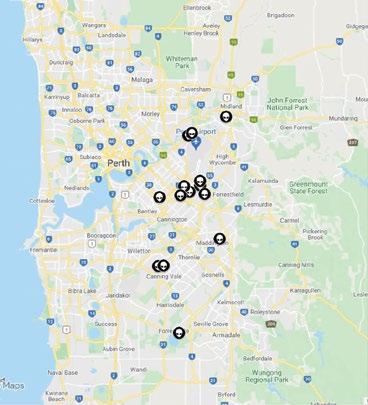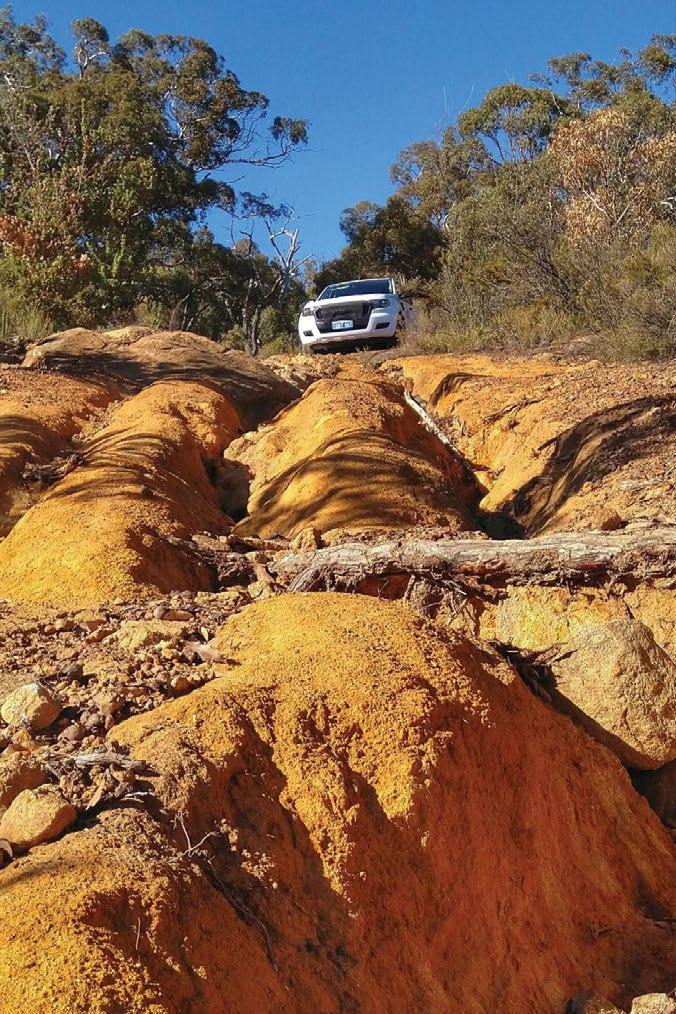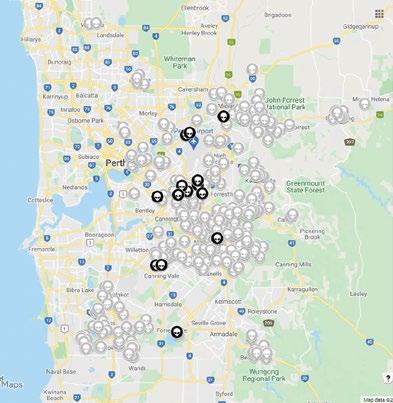
5 minute read
The battle against European wasp
European wasp The battle against
Advertisement
looking back and getting set to move forward!
f 257 baiting stations have been intalled across more than 2,500ha of continuous bushland, ranging from Lesmurdie to Martin.

BY DEPARTMENT OF PRIMARY INDUSTRIES AND REGIONAL DEVELOPMENT
As we get set to declare ‘game-on’ with the start of the year’s European wasp surveillance program, it is a good time to look back on last season — which ended with ‘game-won’!
f EUROPEAN wasps are distinguished by their completely black antennae and they don’t dangle their rear legs when they fly.
The Department of Primary Industries and Regional Development won its biggest battle in 2020–21, with just 14 European wasp nests detected and destroyed — the lowest number in 12 years. This was a huge win for DPIRD’s European wasp surveillance and eradication program, which has been waging war for 44 years to prevent European wasp from establishing in Western Australia.
The establishment of European wasps would have a devastating impact on WA. They have been known to disrupt whole ecosystems, invade beehives, ruin grape and stone fruit crops, and make an outdoor lifestyle impossible.
200
NEST DETECTIONS
150
100
50 The surveillance and eradication program’s continued success has never been achieved in any other Australian state or territory, possibly throughout the world.
DPIRD technical manager John van Schagen said finding only 14 nests in 2020–21 was an incredible outcome for the program, given the starting point in early 2019 when 166 nests were detected — the highest number ever found in WA (see Figures 1 and 2).
0
1977 1980 1983 1986 1992 1995 1998 2001 2004 2007 2010 2013 2016 2019 2021



The mammoth effort has resulted in nest numbers plummeting.

b
f SURVEILLANCE staff faced some rough terrain as they tracked wasps into bushland areas.
c
FIGURE 2. NET DETECTIONS (A) 2018–19; (B) 2019–20; (C) 2020–21.
Added to this great outcome was the discovery that these 14 nests were new wasp incursions, meaning DPIRD had managed to find and kill every nest in 2019–20. Wasp numbers increase when nests remain undetected, as one European wasp nest can lead to 10 new nests in the next season.
Multi-pronged approach
“When we saw the huge spike of nests in early 2019, particularly along the Darling Scarp, the department ramped up its surveillance program and committed three years of additional resourcing to detect, delineate and extinguish wasp hotspots,” Mr van Schagen said. “We also sought and received strong collaboration from local government, other departments and the community, and increased public awareness to encourage reporting of suspected European wasp sightings. This resourcing in 2019 led to a 30% reduction in nests.”
Despite the reduction, Mr van Schagen said another option was needed due the continued spread during the next season of European wasps into unsurpassable bushland areas, making traditional lure, search and destroy methods almost impossible. “It is for this reason we piloted a baiting program in 2019–20, which drew on information from the Eastern States, New Zealand and Israel, and posed negligible risk to non-target species. “We installed 257 baiting stations across more than 2,500ha of continuous bushland, ranging from Lesmurdie to Martin.”


f EUROPEAN wasps look similar to yellow paper wasps but are distinguished by their completely black antennae and they don’t dangle their rear legs when they fly.
FIGURE 3. NUMBER OF NESTS DESTROYED OVER FIVE YEARS — BLACK ICONS SHOW 2020–21 SEASON NESTS.
The result was incredible — no nests were detected in 2020–21 in the baited and hotspot areas across the Perth Hills, including Martin, Orange Grove, Kalamunda, and Mundaring. “We drove European wasps back from the brink of the bush, and the brink of establishment in WA.”
Well earned recognition
Mr van Schagen said the hard work of DPIRD personnel played a huge role in success.
Since 2019 they have deployed more than 3000 surveillance traps each season, and have traversed thousands of hectares. “When the wasps moved into the bushland, finding nests involved some real adventuring and detective work, including trekking and four wheeldriving through thick bushland and rough terrain,” he said. “Finding these nests in the bush was an incredible achievement. Once wasps were detected through traps and lures, personnel needed to trek through dense scrub to follow wasps back to their underground nests and then locate entrances that are usually the size of a 20 cent piece.” Mr van Schagen thanked local governments, the Department of Biodiversity, Conservation and Attractions (DBCA), the Water Corporation, and community groups and residents for their continued support and assistance, including deploying and maintaining traps and helping access bushland areas. “In particular, the support of the City of Kalamunda ‘firies’, who joined us in the hunt for nests in areas we would never have been able to access alone, was crucial over the past few years. “The public also played an important role. Over the years thousands of public enquiries and reports have helped to locate European wasp activity, sometimes leading to the detection of nests.”
The battle continues
European wasps scavenge on dead insects or animals, and human food and drinks. Mr van Schagen said DPIRD will continue to carry out surveillance in the baited areas to ensure localised eradication. The effectiveness and application of the baiting program will be evaluated to determine future use as part of a European wasp integrated pest management strategy. “While the battle of the past few years has been won, the war will never be over,” he said. “European wasp queens will continue to arrive in WA during the warmer months from the Eastern States, mainly on vehicles and freight, and will continue to seed new nests. “However, with a strong and effective surveillance program in place, we can ensure the ongoing detection and eradication of new incursions across WA.”
Remember to look and report!
European wasps look similar to yellow paper wasps but are distinguished by their completely black antennae and they don’t dangle their rear legs when they fly. They also have distinct behaviours such as scavenging on dead insects or animals, and human food and drinks, and they build their nests underground.
MORE INFORMATION
Reports of suspect European wasp sightings can be made via the department’s MyPestGuideTM Reporter app or mypestguide.agric.wa.gov.au, or by contacting the Pest and Disease Information service on (08) 9368 3080 or padis@dpird.wa.gov.au. More information about European wasps, including maps and statistics for the past three surveillance seasons, can be found at agric.wa.gov.au/wasps.
Department of
Primary Industries and Regional Development
Report your observations!
MyPestGuide™ Reporter via online or app mypestguide.agric.wa.gov.au
Pest and Disease Information Service (08) 9368 3080 padis@dpird.wa.gov.au










